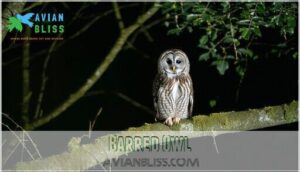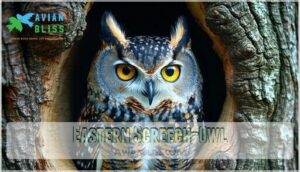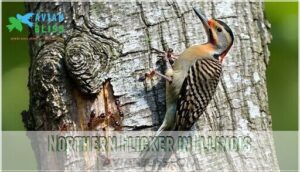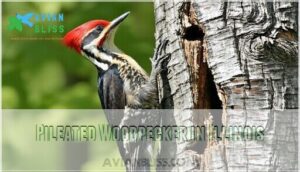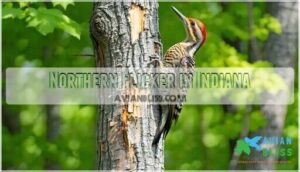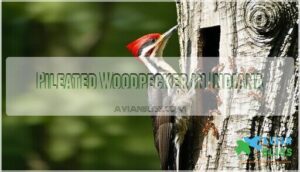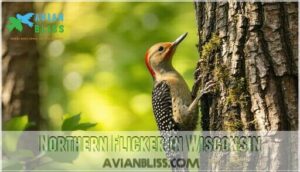This site is supported by our readers. We may earn a commission, at no cost to you, if you purchase through links.
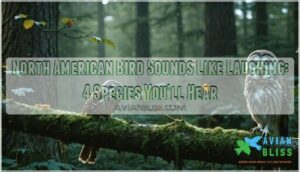
The Barred Owl tops the list with its iconic "who-cooks-for-you" call that dissolves into maniacal laughter, especially at night.
Eastern Screech-Owls contribute their whinnying chuckles, while woodpeckers bring daytime comedy.
The Northern Flicker’s rapid "wicka-wicka-wicka" sounds like giggles, and the Pileated Woodpecker delivers loud, ringing laughs that carry through forest canopies.
These north american bird sounds like laughing serve serious purposes – territory marking and mate attraction – but they’ll leave you grinning like you’re in on nature’s best joke.
Each species has unique timing and habitat preferences worth knowing.
Table Of Contents
- Key Takeaways
- Barred Owl
- Eastern Screech-Owl
- Northern Flicker
- Pileated Woodpecker
- Northern Flicker in Illinois
- Pileated Woodpecker in Illinois
- Northern Flicker in Indiana
- Pileated Woodpecker in Indiana
- Northern Flicker in Wisconsin
- Pileated Woodpecker in Wisconsin
- Frequently Asked Questions (FAQs)
- What bird makes a laughing call?
- What birds make strange sounds?
- What bird sounds like it’s laughing in Illinois?
- What does it mean if a bird laughs?
- What is the weirdest sounding bird?
- Why do birds make a laughing call?
- What bird sounds like it’s laughing?
- What is the American bird that laughs?
- Which bird is known as a laughing bird?
- What bird sounds like it’s saying "hey"?
- Conclusion
Key Takeaways
- You’ll easily recognize four main North American birds that produce laughing sounds: Barred Owls with their iconic "who-cooks-for-you" call, Eastern Screech-Owls with whinnying chuckles, Northern Flickers with rapid "wicka-wicka-wicka" giggles, and Pileated Woodpeckers delivering loud ringing laughs.
- You’re most likely to hear these laughing bird calls during dawn, dusk, and nighttime hours when they’re most vocally active, especially in mature forests near water sources and wooded suburban areas.
- You shouldn’t mistake these sounds for actual laughter – they’re serious communication tools birds use for territory marking, mate attraction, alarm signals, and maintaining contact with flock members.
- You can find these species across various states including Illinois, Indiana, and Wisconsin, where they inhabit different environments from dense woodlands to suburban parks, making them accessible for most bird enthusiasts to encounter.
Barred Owl
Laughter echoes through North America’s forests, but it’s not coming from hikers—it’s the Barred Owl creating these distinctive sounds.
Nature’s comedians aren’t human—they’re feathered entertainers turning forests into outdoor comedy clubs with their unforgettable calls.
You’ll recognize their famous "Who cooks for you? Who cooks for you-all?" call, which serves as both territorial marker and mating invitation.
Barred Owl Habitat centers around mature forests near water sources, where these skilled hunters glide silently on soft-fringed feathers.
Their Barred Owl Diet includes small mammals, amphibians, and fish, making wetland areas perfect hunting grounds.
Barred Owl Behavior includes year-round residence—they don’t migrate like many north american birds.
These laughing bird sounds and complex bird vocalizations help establish territory and attract mates.
Barred Owl Calls range from hoots to cackles, creating the bird sounds like laughing that make them unforgettable forest residents requiring ongoing Barred Owl Conservation efforts.
As nocturnal hunters, Barred Owls share this trait with the similarly adaptable barn owl.
Eastern Screech-Owl
While Barred Owls grab attention with their "who cooks for you" hoots, the Eastern Screech-Owl offers something entirely different. Don’t let their small size fool you—these pocket-sized predators pack serious vocal punch with eerie calls that’ll make your skin crawl.
You’ll hear their signature trill sounds and haunting whinny calls echoing through North American neighborhoods after dark.
These bird vocalizations serve multiple purposes: attracting mates, defending territory, and coordinating hunts. Their owl diet includes insects, small mammals, and birds they snatch with surprising stealth.
Eastern ScreechOwls adapt well to suburban areas, but habitat loss threatens their populations. The closely related Western Screech-Owl also utilizes similar nesting sites in tree cavities or nest boxes.
While their bird sounds don’t exactly sound like laughing, they’re unmistakably memorable. Listen for these complex calls—they’re among nature’s most spine-tingling bird sounds.
Northern Flicker
Why does the Northern Flicker sound like it’s telling jokes? This large woodpecker’s distinctive "ha-ha-ha-ha" call creates memorable bird vocalizations that’ll stick with you.
Unlike typical north american birds, Flickers spend time on the ground, showcasing unique Flicker Behavior as they hunt ants and beetles. Their Flicker Diet consists mainly of insects they dig up with curved bills.
You’ll spot these bird sounds masters in diverse Flicker Habitat ranging from woodlands to city parks, drumming on hollow trees and utility poles. Their spotted breast and vibrant yellow or red feather shafts make identification easy.
Flicker Conservation efforts focus on protecting habitats from deforestation and pesticide use, ensuring future generations can enjoy their laughing serenades. Similarly, other birds such as the Northern Mockingbird exhibit remarkable vocal abilities by mimicking other species.
Pileated Woodpecker
Picture hearing a deep, resonant call echoing through the forest – that’s your Pileated Woodpecker announcing its presence. This crow-sized woodpecker creates some of the most distinctive bird sounds among north american birds, producing powerful drumming sounds that can be heard nearly a mile away.
The forest’s percussionist strikes again – Pileated Woodpeckers drumming their wild symphony through ancient trees.
You’ll recognize their laughing-like calls during spring territorial displays and courtship rituals. These impressive woodpeckers have fascinating nesting habits, excavating rectangular cavities in dead trees where both parents share incubation duties.
Their diet consists primarily of carpenter ants, which they extract using their specialized tongues. Unfortunately, habitat loss threatens these magnificent birds. Conservation efforts focus on preserving large forest blocks, ensuring their iconic bird vocalizations continue enriching our woodlands for future generations.
They’re non-migratory birds, and solitary roosting habits help them conserve energy during the winter months.
Northern Flicker in Illinois
When you’re exploring Illinois’s diverse landscapes, you’ll likely encounter the Northern Flicker, a woodpecker that’s anything but ordinary.
This North American bird produces distinctive "ha-ha-ha-ha" calls that sound remarkably like human laughter, making Flicker Identification surprisingly easy through bird call analysis.
Flicker Habitat in Illinois includes open woodlands, suburban areas, and parks where these birds excavate nesting cavities in trees, fence posts, or buildings.
Their Flicker Behavior includes drumming on utility poles and metal surfaces, creating rhythmic beats that echo through neighborhoods.
Flicker Diet consists primarily of ants and beetles, which they dig up with slightly curved bills, plus seasonal berries.
Flicker Conservation efforts focus on preserving grassland habitats and reducing pesticide use, as these bird sounds in Illinois have become less common due to habitat loss over recent decades.
You can also attract them by planting native trees in your backyard.
Pileated Woodpecker in Illinois
Throughout Illinois’s dense woodlands, you’ll discover the magnificent Pileated Woodpecker creating its signature laugh-like calls that echo through mature forests. This crow-sized bird represents one of North America’s most impressive woodpeckers, with its flaming-red crest and bold white neck stripes making identification straightforward.
Despite habitat loss concerns, Illinois populations are actually increasing in northern regions, thanks to ongoing conservation efforts focused on preserving large forest tracts. The Pileated Woodpecker thrives in coniferous and deciduous forests, where they can find ample food and nesting sites.
- Rectangular feeding holes carved into dead trees mark their territory
- Resounding drumming that carries for miles through quiet forests
- 30-inch wingspan creating dramatic flight displays between towering oaks
- Distinctive "ha-ha-ha-ha" calls for sound comparison with other species
- Year-round presence in southern Illinois’s heavily forested areas
Local behavior includes their relentless search for carpenter ants, leaving unique rectangular excavations that benefit other wildlife species seeking shelter.
Northern Flicker in Indiana
You’ll stumble upon the Northern Flicker‘s unmistakable "ha-ha-ha-ha" call echoing through Indiana’s woodlands and suburban parks.
This medium-sized woodpecker stands out with its boldly-patterned underparts, brownish-red back, and distinctive yellow feather shafts that flash during flight.
Flicker Behavior sets them apart from other woodpeckers – they’re ground foragers who probe soil and anthills for ants, their favorite meal.
Flicker Diet includes grubs, beetles, and insects found in rotting wood and even cow dung.
Their Flicker Habitat spans forests, parks, and suburban areas throughout Indiana.
Flicker Conservation efforts focus on preserving dead trees essential for nesting cavities.
These North American bird sounds contribute to Indiana’s rich avian chorus, making bird calls identification rewarding for nature enthusiasts exploring Flicker Sounds across the state.
They’re also known for their unique drumming patterns.
Pileated Woodpecker in Indiana
Indiana’s crow-sized Pileated Woodpecker delivers some of the most distinctive bird sounds you’ll encounter in the Hoosier State.
These impressive North American birds produce loud, reverberating calls that echo through Indiana Habitat consisting of mature forests with abundant dead trees. Their Call Variations include sharp "kuk-kuk-kuk" notes and wild, maniacal laughter-like sequences that’ll make you stop in your tracks.
Drumming Behavior creates thunderous percussion as they excavate rectangular holes while hunting carpenter ants. Local Sightings often occur in state parks and wooded areas with standing snags. Listen for their bird calls during morning hours when they’re most active.
Pileated Woodpeckers are essential because they create nesting cavities utilized by other wildlife.
Despite their impressive presence, Conservation Status remains stable, though habitat loss poses ongoing challenges. These remarkable birds demonstrate nature’s percussion section at its finest, making bird sounds in Indiana truly unforgettable experiences for any outdoor enthusiast.
Northern Flicker in Wisconsin
What makes Wisconsin’s Northern Flicker stand out among North American birds? This colorful woodpecker produces distinctive "ha-ha-ha-ha" calls that echo through the state’s open woodlands.
You’ll find these medium-sized birds foraging on the ground for ants and beetles, unlike most woodpecker species. Their Flicker Behavior includes drumming on trees at 25 strikes per second and making loud "kyeer" calls.
Wisconsin’s Flicker Habitat encompasses:
- Open, dry areas adjacent to forests with dead trees for nesting cavities
- Recently burned or cut areas with scattered snags providing ideal conditions
The Northern Flicker’s Flicker Diet consists primarily of ants, making them vital pest controllers. Unfortunately, Flicker Conservation efforts face challenges as populations have declined substantially.
The loss of suitable nesting snags threatens these bird species, making habitat preservation essential for maintaining their unique bird sounds across Wisconsin’s landscapes. They also need shelter and native plants for survival.
Pileated Woodpecker in Wisconsin
Wisconsin’s largest Pileated Woodpecker creates some of the most distinctive North American bird sounds you’ll encounter in mature forests.
These crow-sized birds produce loud, reverberating calls and slow, measured woodpecker drumming that echoes through the woods like nature’s own percussion section.
You’ll find them in northern pine forests, boreal regions, and mesic woodlands throughout the state.
Their foraging behavior involves excavating large, rectangular holes in dead trees while hunting for carpenter ants and wood-boring beetles.
Listen for their call variations – from territorial announcements to mate communication – especially during breeding season.
Their nesting habits require mature forest stands with large trees for cavity excavation.
Wisconsin’s expanding forested cover has helped increase their Wisconsin distribution, particularly in the southeast.
However, habitat conservation remains essential as intensively managed young forests can limit local populations.
These monogamous birds defend their territory with bold vocalizations that you won’t soon forget.
They require habitats with mature forests and deadwood for survival.
Frequently Asked Questions (FAQs)
What bird makes a laughing call?
Nature’s comedians fill the skies with their distinctive chuckles. You’ll recognize the Laughing Kookaburra‘s iconic "koo-hoo-hoo-haa-haa-haa" cackle, while Northern Flickers produce rhythmic "ha-ha-ha-ha" calls that’ll make you smile every time.
What birds make strange sounds?
You’ll encounter birds making bizarre sounds throughout North America.
Atlantic Puffins cackle creepily, American Bitterns sound like dripping faucets, Willow Ptarmigans bark nasally like cartoons, and Green Cat Birds scream like children—nature’s wild orchestra.
What bird sounds like it’s laughing in Illinois?
You’ll hear the Northern Flicker‘s distinctive "ha-ha-ha-ha" call echoing through Illinois woodlands. This large woodpecker’s rhythmic laughter-like sound is unmistakable, especially during spring when they’re establishing territories and attracting mates.
What does it mean if a bird laughs?
Like nature’s comedian taking the stage, when you hear a bird "laughing," it’s actually communicating through specialized calls.
These sounds serve territorial disputes, courtship displays, alarm signals, or social bonding—not genuine amusement.
What is the weirdest sounding bird?
You’ll crack up hearing the Willow Ptarmigan’s nasally bark that sounds like a cartoon character.
The Green Cat Bird’s child-like screaming in Australia’s bush will also amuse you, and the Atlantic Puffin’s creepy cackling will definitely surprise you with its unique sound, making it a creepy experience.
Why do birds make a laughing call?
Birds make laughing calls primarily for communication purposes.
You’ll notice they use these distinctive sounds to establish territory, attract mates, signal alarm, and maintain contact with their flock members effectively.
What bird sounds like it’s laughing?
Ever wondered which feathered comedian’s stealing the show in your backyard?
You’ll recognize the Laughing Kookaburra’s iconic "koo-hoo-hoo-haa-haa" call, though Northern Flickers and Common Loons also produce distinctive laugh-like sounds that’ll make you chuckle.
What is the American bird that laughs?
You’ll hear the Common Loon’s trembling laugh echoing across northern lakes, while the Laughing Kookaburra (though Australian) and Northern Flicker produce distinctive "ha-ha-ha" calls that’ll make you smile.
Which bird is known as a laughing bird?
The Laughing Kookaburra from Australia earns its nickname with distinctive "koo-hoo-hoo-haa-haa-haa" calls that sound like cackling laughter.
You’ll recognize this iconic sound from movies featuring jungle scenes, though it’s actually an Australian native.
What bird sounds like it’s saying "hey"?
You’ll chuckle when hearing the Northern Flicker‘s distinctive "hey-hey-hey" call echoing through woodlands. This large woodpecker‘s rhythmic greeting sounds remarkably like someone shouting a friendly hello from the treetops above.
Conclusion
Last spring, a Michigan hiker mistook a Barred Owl’s territorial call for actual human laughter echoing through the woods.
You’ll likely experience similar moments when encountering these fascinating species.
Whether you’re camping in Wisconsin’s forests or walking Indiana’s woodlands, these north american bird sounds like laughing will surprise and delight you.
Listen carefully during dawn, dusk, and nighttime hours when these vocal performers are most active.
Their calls serve essential communication purposes while providing endless entertainment for outdoor enthusiasts, making them a unique experience to enjoy in nature, with their sounds being an integral part of the north american bird sounds and overall outdoor experience.

